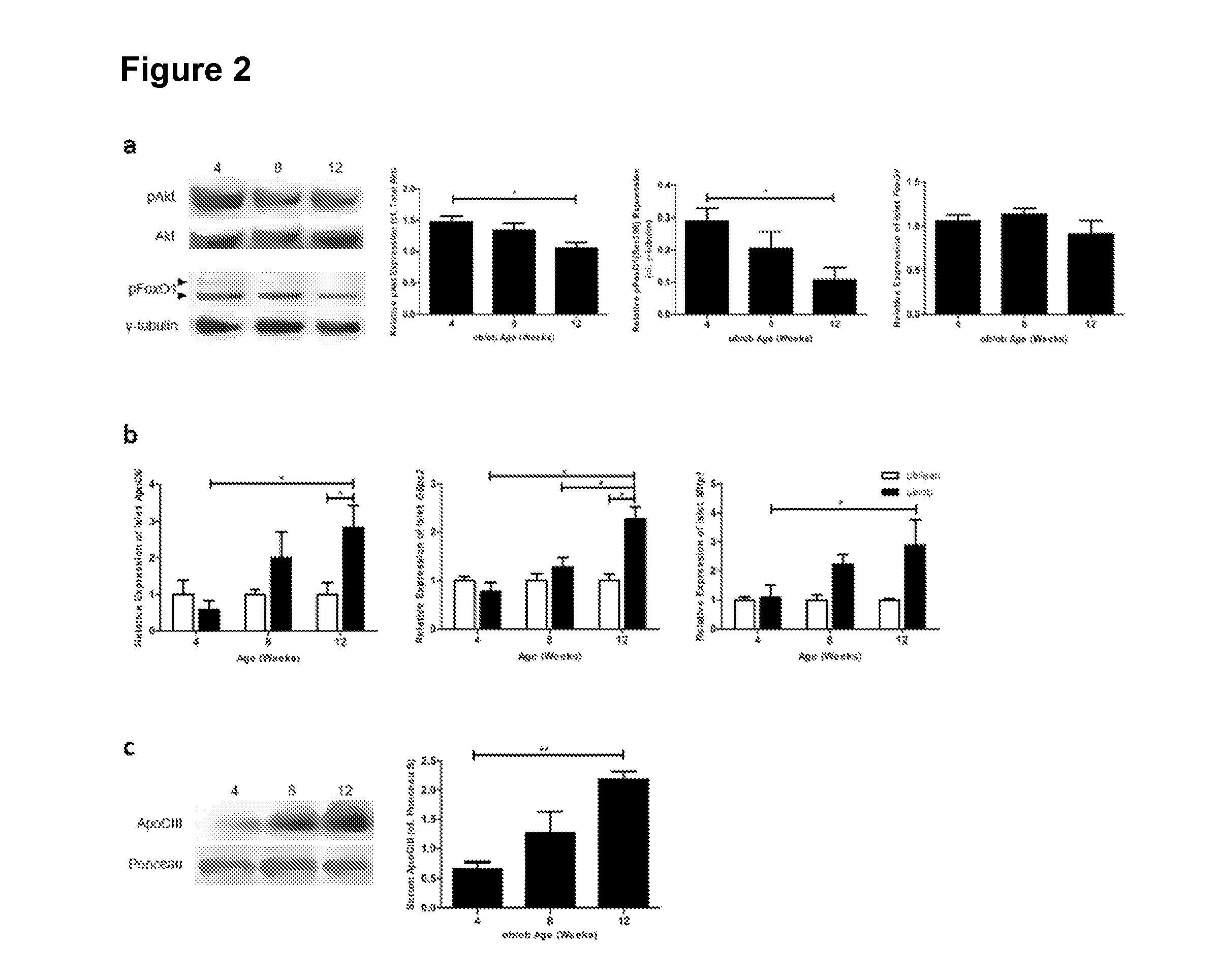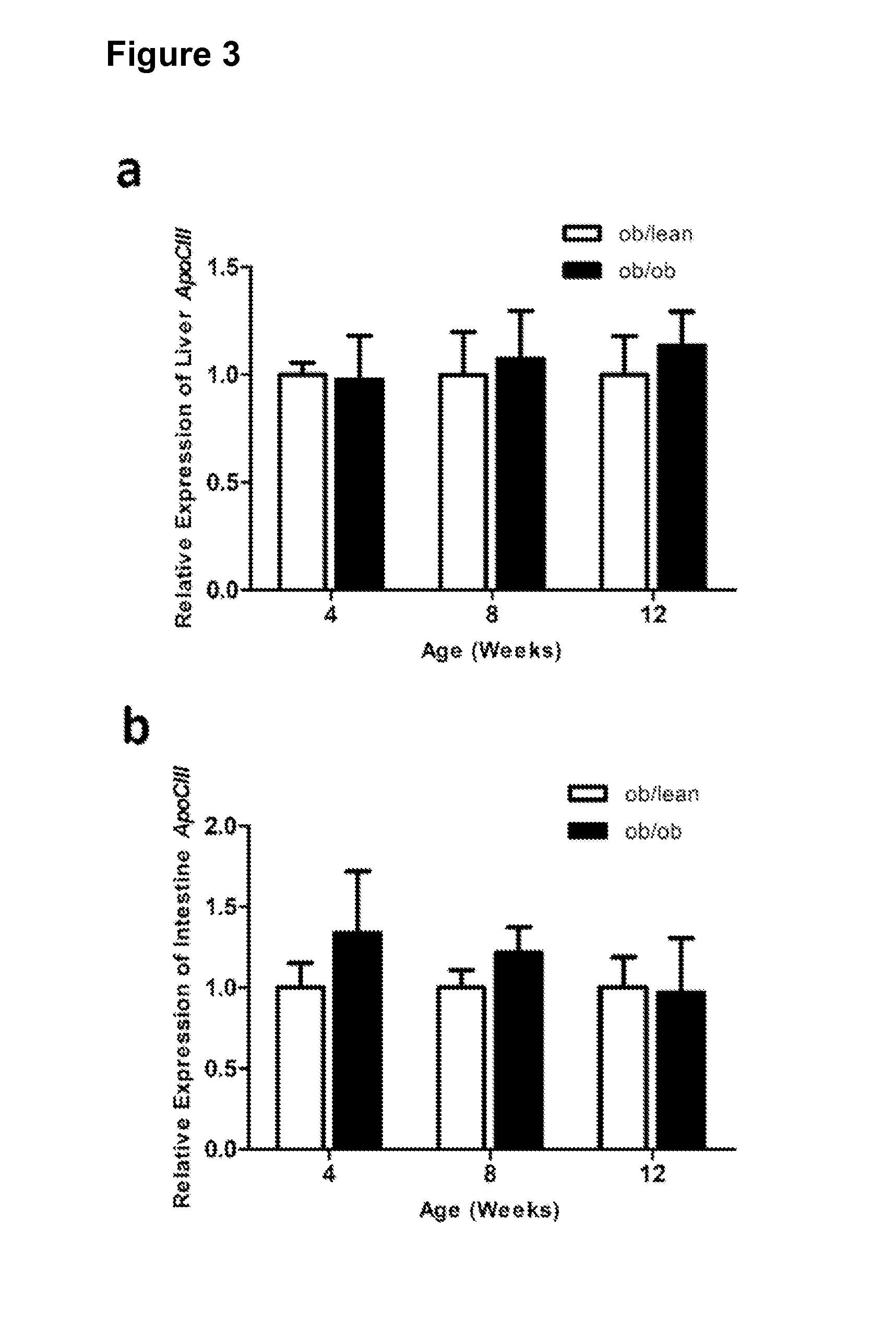Methods for treating and/or limiting development of diabetes
a technology for limiting the development of diabetes and treating it, applied in the direction of antibody mimetics/scaffolds, biochemistry apparatus and processes, pharmaceutical non-active ingredients, etc., can solve problems such as glucose handling defects
- Summary
- Abstract
- Description
- Claims
- Application Information
AI Technical Summary
Benefits of technology
Problems solved by technology
Method used
Image
Examples
example 1
Insulin Signaling in ob / ob Islets
[0070]To determine the changes in insulin signaling in ob / ob mouse islets, which consist of more than 90% β-cells, the phenotypic changes were tracked in these mice at 4, 8 and 12 weeks of age, measuring parameters such as body weight, non-fasting blood glucose and insulin concentrations. Age-matched ob / lean mice that were routinely genotyped from 4 weeks onwards were used as controls. Since the ob / ob mouse is a known transient hyperglycemia model with increasing hyperglycemia up to 14 weeks of age, the study was limited to the first 12 weeks of age and found that both weight and non-fasting blood glucose levels progressively increased from 4- to 12-weeks of age (FIG. 1a and FIG. 1b). However, the non-fasting insulin levels in the ob / ob mice remained higher than in control animals (FIG. 1c).
[0071]With prolonged hyperinsulinemia, insulin signaling at the islet level may be compromised, similar to what is seen in the β-cell-specific insulin receptor kn...
example 2
Progressive Change of FoxO1-Regulated Gene Expression in ob / ob Islets Over Time
[0072]One of the ways in which insulin induces changes in gene expression is through the phosphorylation cascade of Akt and its downstream target forkhead transcription factor FoxO1. Insulin-mediated activation of Akt leads to the phosphorylation of FoxO1 with its nuclear exclusion and loss of transcriptional activity. This signaling cascade has been shown to be crucial in maintaining β-cell function and proliferation during either insulin resistance or insult / injury. Levels of phospho-Akt and phospho-FoxO1 in ob / ob islets were determined at 4-, 8- and 12-weeks of age. There was a significant reduction in phospho-Akt (Ser473) and phospho-FoxO1 (Ser256) in the 12-weeks old ob / ob islet as compared to the islets at 4-weeks of age (FIG. 2a). Total Akt protein levels within these islets were not significantly different across time. Messenger RNA levels of FoxO1 were determined, and found no significant differe...
example 3
ApoCIII is Detected in Both ob / ob Mice and Human Pancreatic Islets
[0076]The presence of apoCIII in pancreatic islet has not been observed before and is interesting since this apolipoprotein is known to be involved in both β-cell dysfunction and T1DM. A proteomic characterization of single pancreatic islets showed presence of apoCIII. However, this can be the result of either systemic circulating apoCIII residing within the microvasculature of pancreatic islets or, as shown here, a local production of apoCIII within the islet itself Comparatively, the expression of apoCIII in ob / lean pancreatic islets is about 3000-fold lower compared to the liver (FIG. 4a). The small intestine, the other known organ expressing apoCIII, has an expression that is 10-fold lower compared to the liver, but 300-fold higher compared to islet apoCIII expression. Nevertheless, a three-fold increase in apoCIII mRNA seen in the 12-weeks old ob / ob islet may exert profound autocrine / paracrine effects within the ...
PUM
| Property | Measurement | Unit |
|---|---|---|
| temperature | aaaaa | aaaaa |
| pH | aaaaa | aaaaa |
| excitation wavelengths | aaaaa | aaaaa |
Abstract
Description
Claims
Application Information
 Login to View More
Login to View More - R&D
- Intellectual Property
- Life Sciences
- Materials
- Tech Scout
- Unparalleled Data Quality
- Higher Quality Content
- 60% Fewer Hallucinations
Browse by: Latest US Patents, China's latest patents, Technical Efficacy Thesaurus, Application Domain, Technology Topic, Popular Technical Reports.
© 2025 PatSnap. All rights reserved.Legal|Privacy policy|Modern Slavery Act Transparency Statement|Sitemap|About US| Contact US: help@patsnap.com



